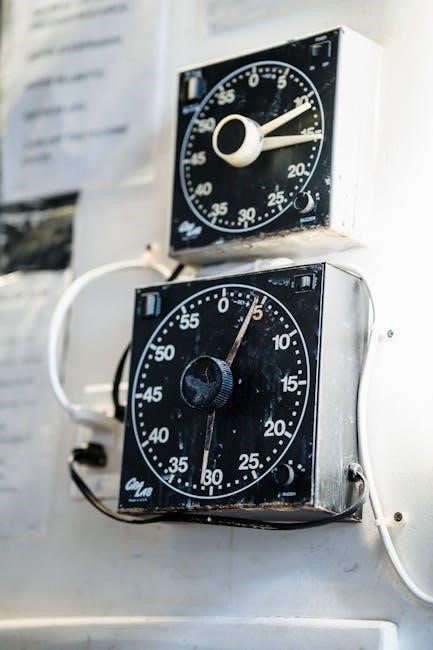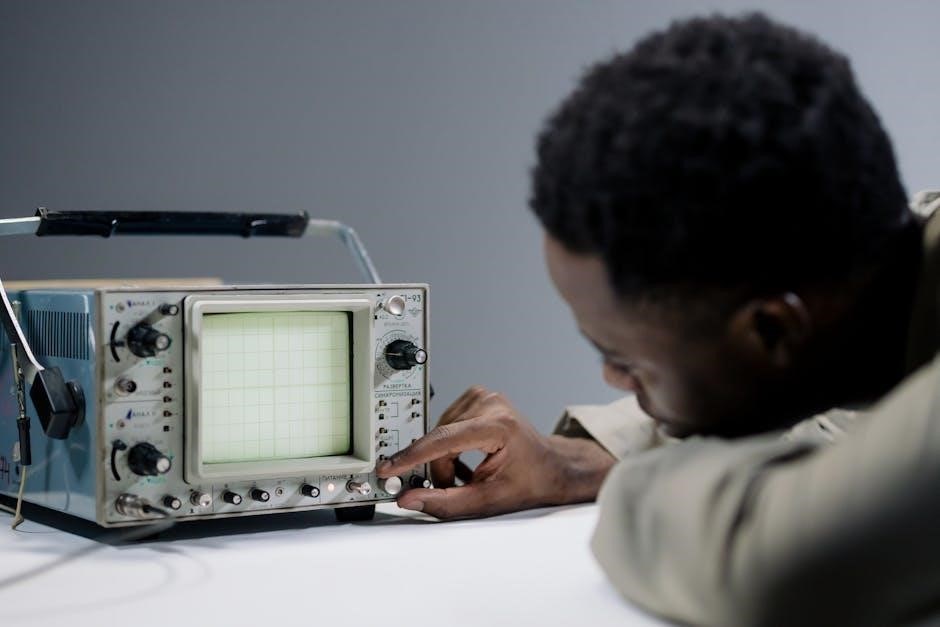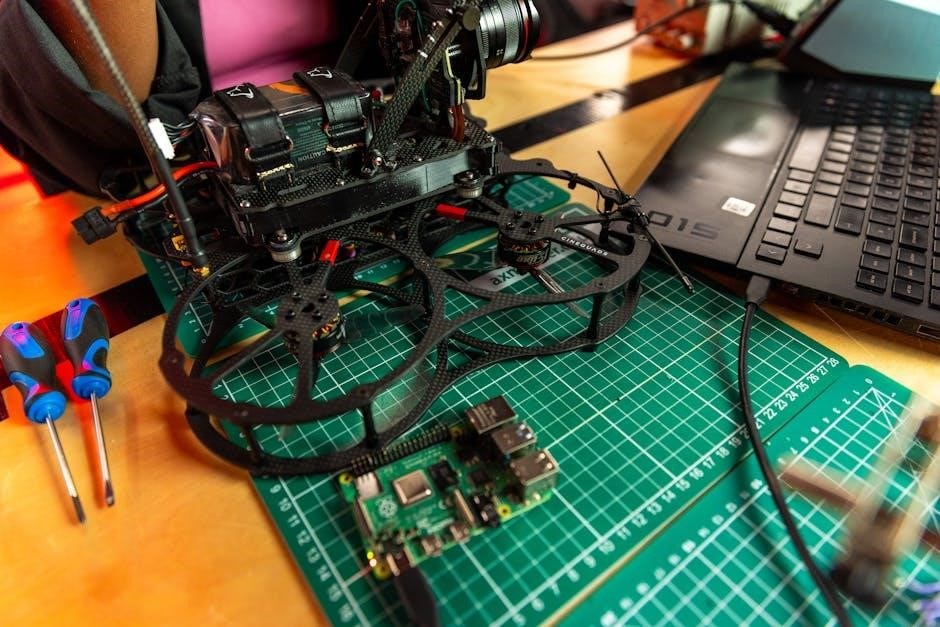
Welcome to the KE2 Controller Manual, your comprehensive guide to understanding and operating the advanced features of the KE2 Therm Solutions controller. This manual provides detailed instructions, troubleshooting tips, and operational insights to ensure optimal performance and energy efficiency. Designed for both novice and experienced users, it covers installation, setup, and maintenance, helping you maximize the controller’s capabilities and extend its lifespan. Whether you’re installing a new system or upgrading an existing one, this manual is your essential resource for seamless operation.
1.1 Overview of the KE2 Controller
The KE2 Controller is a state-of-the-art device designed for precise temperature control and energy management. It features advanced adaptive control technology, customizable defrost modes, and seamless integration with other systems. User-friendly and efficient, the controller ensures optimal performance while minimizing energy consumption. Its robust design and intuitive interface make it ideal for various applications, including refrigeration and HVAC systems. With cutting-edge technology and reliable operation, the KE2 Controller is a versatile solution for modern control needs, offering both simplicity and sophistication.
1.2 Importance of the Manual for Users
This manual is an essential resource for understanding and utilizing the KE2 Controller effectively. It provides detailed guidance on installation, operation, and troubleshooting, ensuring users can maximize the controller’s performance. The manual includes error code explanations, maintenance tips, and step-by-step instructions, helping users resolve issues quickly. By following the manual, users can ensure safe and efficient operation, customize settings, and maintain the controller’s longevity. It serves as a comprehensive guide for both initial setup and ongoing management of the KE2 Controller.

Installation and Setup Guide
This section provides a detailed installation and setup guide for the KE2 Controller, including pre-installation requirements, step-by-step instructions, wiring diagrams, and mounting procedures to ensure proper function and efficiency.
2.1 Pre-Installation Requirements

Before installing the KE2 Controller, ensure the following requirements are met: Verify the power supply matches the controller’s specifications, typically 120V AC. Check compatibility with existing systems and ensure all necessary wiring and connectors are available. The installation site must be clean, dry, and within the recommended operating temperature range. Review the wiring diagrams provided in the manual to avoid electrical mismatches. Ensure all safety precautions, such as disconnecting power sources, are followed. Familiarize yourself with the controller’s dimensions to plan mounting appropriately. Confirm all components, including sensors and defrost modules, are included in the package. Proper preparation ensures a smooth and successful installation process.
2.2 Step-by-Step Installation Instructions
Power off the system and ensure all components are disconnected. 2. Mount the controller securely, following the provided dimensions for proper alignment. 3. Connect the power supply to the controller, ensuring polarity matches the wiring diagram. 4. Attach sensors and defrost modules to their respective terminals. 5. Restore power and initialize the system. 6. Navigate to the setup menu to configure basic settings. 7. Test all functions, including defrost modes and system responses. 8. Verify error-free operation before finalizing the installation. Follow these steps carefully to ensure proper functionality and safety.
2.3 Wiring Diagrams and Connections
Refer to the official wiring diagrams provided in the KE2 Controller Manual for precise connections. Ensure all terminals are correctly matched, starting with the power supply and sensor inputs. Connect defrost modules and output relays according to the schematic. Verify polarity and tighten connections to the specified torque. Double-check compatibility with existing systems before powering up. Consult the manual for detailed wiring instructions and troubleshooting tips to avoid installation errors. Proper connections are critical for optimal performance and safety.
2.4 Mounting the Controller
Mount the KE2 Controller securely on a flat surface using the provided mounting brackets. Ensure the location is dry, cool, and free from vibrations. Align the controller with the specified orientation to prevent damage. Use screws of the recommended size and torque to avoid over-tightening. Refer to the manual for precise dimensions and mounting hole locations. Ensure proper ventilation around the unit to maintain optimal operating temperatures. Follow all safety guidelines to guarantee reliable performance and longevity of the controller. Consult the manual for additional mounting requirements and considerations.

Operating Instructions
Start the system by powering on the controller and follow the on-screen prompts. Use the basic controls to navigate menus, set operating modes, and monitor performance for efficient operation.
3.1 Basic Controls and Functions
The KE2 controller features an intuitive interface with basic controls designed for easy operation. The touchscreen display allows users to navigate through menus, adjust settings, and monitor system performance. Key functions include temperature setpoints, defrost mode selection, and system status monitoring. Users can access shortcuts for common tasks, ensuring efficient operation. The controller also provides real-time feedback through LED indicators and on-screen alerts, making it simple to identify and address system changes or issues promptly. Mastering these controls ensures seamless and effective system management.
3.2 Navigating the Display Menu
Navigating the KE2 controller’s display menu is straightforward, with a touchscreen interface designed for user-friendly operation. The main menu includes options like Home, Settings, and Monitor, allowing quick access to essential functions. Use navigation buttons to scroll through menus, select options, and return to previous screens. The display provides clear visual feedback, with status indicators showing active modes and settings. Users can access real-time data, adjust parameters, and view diagnostic information efficiently. The menu system is intuitive, ensuring easy operation for both experienced users and newcomers alike.
3.3 Setting Up Defrost Modes
The KE2 controller offers multiple defrost modes to optimize system performance and energy efficiency. Access the defrost settings through the display menu under the “System Mode” section. Choose from automatic, manual, or adaptive defrost options. Automatic defrost activates based on predefined schedules, while manual mode allows on-demand defrost initiation. Adaptive defrost adjusts intervals and durations dynamically, minimizing energy use. Set defrost intervals and durations according to your system’s needs to prevent ice buildup and maintain efficiency. Proper setup ensures reliable operation and extends equipment lifespan, making it essential for optimal performance.
3.4 Understanding System Modes
The KE2 controller operates in various system modes to manage your equipment effectively. These modes include Run, Standby, and Defrost, each designed for specific operational needs. The Run mode activates normal operation, while Standby pauses non-essential functions to conserve energy. The Defrost mode ensures ice buildup is prevented, maintaining efficiency. Access these modes via the display menu and adjust parameters to suit your system’s requirements. Proper mode selection optimizes performance, reduces energy consumption, and extends equipment lifespan. Familiarize yourself with these modes to achieve seamless control and efficiency.

Features of the KE2 Controller
The KE2 controller offers advanced features like adaptive control technology, energy-saving modes, customizable defrost settings, and seamless integration with other systems, ensuring optimal performance and efficiency.
4.1 Defrost Parameter Settings
The KE2 controller provides precise defrost parameter settings, allowing users to customize defrost modes, duration, and frequency. These settings ensure efficient frost removal while maintaining optimal system performance. Advanced algorithms adapt to varying conditions, optimizing energy use and preventing unnecessary defrost cycles. Users can manually override or schedule defrost operations, enhancing flexibility. Detailed instructions in the manual guide users through configuring these settings to meet specific application needs, ensuring reliable operation across diverse environments.
4.2 Adaptive Control Technology
The KE2 controller features advanced adaptive control technology, which dynamically adjusts system parameters based on real-time environmental conditions. This intelligent system optimizes performance by learning from operational data, ensuring efficient energy use and consistent results. Adaptive control reduces manual interventions, automates defrost cycles, and maintains precise temperature control. It also minimizes wear on components by avoiding unnecessary operations, extending the system’s lifespan. This technology ensures the controller adapts seamlessly to varying loads and external factors, delivering reliable and efficient performance across diverse applications.
4.3 Energy-Saving Capabilities

The KE2 controller is equipped with advanced energy-saving features designed to reduce power consumption while maintaining optimal performance. By utilizing smart defrost management and adaptive load monitoring, the system minimizes unnecessary energy use. The controller’s intelligent algorithms adjust operations based on real-time conditions, ensuring efficient energy utilization. This not only lowers operational costs but also contributes to environmental sustainability. With its energy-efficient design, the KE2 controller is an eco-friendly solution for modern applications, balancing performance and resource conservation seamlessly.
4.4 Integration with Other Systems
The KE2 controller seamlessly integrates with various systems and devices, enhancing overall operational efficiency. It is compatible with popular control systems and communication protocols, ensuring smooth interaction with existing infrastructure. This capability allows for centralized monitoring and control, enabling users to manage multiple components from a single interface. The controller’s adaptability makes it an ideal solution for integrated systems, supporting scalability and future upgrades. Detailed instructions for system integration are provided in the manual, ensuring a hassle-free setup process.

Troubleshooting and Maintenance

This section provides essential troubleshooting steps and maintenance tips to resolve common issues with the KE2 controller. Regular maintenance ensures optimal performance and extends lifespan. Use diagnostic tools for quick solutions and refer to the manual for detailed procedures to keep your system running smoothly.
5.1 Common Error Codes and Solutions
The KE2 controller may display error codes like E1 or E2, indicating issues such as communication errors or sensor malfunctions. Refer to the manual for specific solutions. For E1, check wiring connections and ensure proper power supply. For E2, verify sensor calibration and clean or replace faulty sensors. Reset the controller if issues persist. Always consult the troubleshooting guide for detailed repair steps and preventive maintenance tips to ensure smooth operation and minimize downtime. Regular checks can help identify potential problems early, ensuring optimal system performance and reliability. Use diagnostic tools for quick solutions and maintain your system efficiently.
5.2 Diagnosing Hardware Issues
Diagnosing hardware issues with the KE2 controller involves systematic checks. Start by inspecting wiring connections for damage or loose contacts. Ensure all sensors and relays are properly connected. Check the power supply to confirm it meets the controller’s requirements. Verify that defrost heaters and fans are functioning correctly. Consult the wiring diagram in the manual for accurate connections. If issues persist, use diagnostic tools to identify faulty components like sensors or contactors. Replace any damaged parts and test the system to ensure proper operation. Regular hardware checks prevent unexpected failures and maintain efficiency. Always refer to the manual for specific troubleshooting procedures. Use the error codes as a guide to pinpoint the source of the problem. If unsure, contact KE2 Therm Solutions support for assistance. Keep a record of maintenance and repairs for future reference. By addressing hardware issues promptly, you can ensure reliable performance and extend the controller’s lifespan. Use genuine replacement parts to avoid compatibility problems. Familiarize yourself with the controller’s electrical schematic for advanced troubleshooting. For complex issues, consult a certified technician. Remember, proper diagnosis is key to resolving hardware malfunctions effectively. Use the controller’s built-in diagnostic features to simplify the process. Always follow safety guidelines when handling electrical components to prevent accidents. Ensure the system is powered off before performing any hardware inspections or repairs. Use multimeters or other tools to test voltage and resistance. Document your findings to track recurring issues and improve system maintenance. By taking these steps, you can efficiently diagnose and resolve hardware-related problems with your KE2 controller.
5.3 Performing Routine Maintenance
Routine maintenance is crucial for ensuring the KE2 controller operates efficiently. Regularly clean the controller’s exterior and internal components to prevent dust buildup. Inspect wiring connections for tightness and integrity; Verify that all sensors are calibrated correctly and functioning as intended. Check the firmware version and update it if necessary. Review system logs to identify potential issues before they escalate. Schedule periodic checks of defrost heaters, fans, and relays to ensure proper operation. Replace worn or damaged components promptly. Maintain a record of maintenance activities to track performance over time. By adhering to a routine maintenance schedule, you can prevent unexpected downtime and ensure optimal system performance. Always refer to the manual for specific maintenance recommendations tailored to your controller model. Regular upkeep extends the lifespan of the controller and maintains energy efficiency. Use genuine replacement parts for any repairs to guarantee compatibility and reliability. Familiarize yourself with the controller’s diagnostic tools to monitor system health proactively. Address minor issues before they develop into major problems. Consistent maintenance ensures the controller continues to meet your operational needs effectively. Keep the manual handy for guidance on specific maintenance procedures. Routine checks are essential for sustaining peak performance and minimizing repairs. Stay proactive to ensure your KE2 controller remains in excellent working condition. Use the controller’s built-in maintenance reminders to stay on track with scheduled tasks. Regular maintenance is a simple yet effective way to protect your investment and ensure long-term efficiency. By prioritizing routine upkeep, you can rely on the KE2 controller to deliver consistent results. Always follow the recommended maintenance schedule outlined in the manual. This will help prevent unexpected failures and ensure smooth operation. Regular maintenance is key to maximizing the controller’s performance and extending its service life. Use the resources provided in the manual to guide your maintenance efforts. Keep your system running smoothly with consistent, thorough upkeep. The KE2 controller’s reliability depends on your commitment to routine maintenance. Make it a priority to ensure uninterrupted performance and efficiency. Regular checks and updates will keep your system functioning at its best. Stay informed and proactive with the KE2 controller’s maintenance requirements. Your diligence will pay off in the form of reliable operation and extended lifespan. Always refer to the manual for detailed maintenance instructions specific to your controller model. By doing so, you can ensure all aspects of the system are properly maintained. Regular maintenance is a critical part of owning and operating the KE2 controller. It ensures that every component works together seamlessly for optimal performance. Take the time to perform routine checks and updates to keep your system in top condition. The KE2 controller is designed to provide years of reliable service with proper care. Make routine maintenance a part of your regular routine to enjoy consistent results. Your attention to maintenance will help prevent issues and ensure the controller continues to meet your needs. Stay proactive and keep your system running smoothly with regular upkeep. The KE2 controller’s performance and longevity depend on it. Always follow the manual’s guidelines for routine maintenance to ensure the best results. By doing so, you can maintain efficiency, prevent downtime, and extend the life of your controller. Regular maintenance is essential for protecting your investment and ensuring continued satisfaction with the KE2 controller. Make it a priority to perform routine checks and updates as recommended. Your efforts will be rewarded with reliable performance and minimal interruptions. The KE2 controller is a valuable asset, and routine maintenance is key to preserving its functionality. Stay informed and proactive to keep your system operating at its best. Regular maintenance ensures the KE2 controller remains a dependable and efficient solution for your needs. Always refer to the manual for specific guidance on maintaining your controller. By following the recommended schedule, you can prevent potential issues and enjoy uninterrupted service. The KE2 controller is designed for durability, but it requires consistent upkeep to perform at its best. Make routine maintenance a priority to ensure long-term reliability and efficiency. Your dedication to maintenance will ensure the controller continues to deliver exceptional results. Regular maintenance is a simple yet crucial step in preserving the functionality of your KE2 controller. Stay committed to routine checks and updates to keep your system running smoothly. The KE2 controller’s performance and longevity depend on your attention to maintenance. Always follow the manual’s recommendations to ensure optimal results. By prioritizing routine maintenance, you can protect your investment and enjoy the benefits of the KE2 controller for years to come. Regular upkeep is essential for maintaining the controller’s efficiency and reliability. Make it a part of your routine to ensure consistent performance. The KE2 controller is a sophisticated device that requires careful maintenance to function at its best. Stay proactive and follow the manual’s guidelines to keep your system in top condition. Regular maintenance is a critical aspect of owning and operating the KE2 controller. It ensures that every component works together seamlessly for optimal performance. By prioritizing routine checks and updates, you can prevent unexpected issues and extend the life of your controller. The KE2 controller is designed to provide years of reliable service with proper care. Make routine maintenance a part of your regular routine to enjoy consistent results. Your attention to maintenance will help prevent issues and ensure the controller continues to meet your needs. Stay proactive and keep your system running smoothly with regular upkeep. The KE2 controller’s performance and longevity depend on it. Always follow the manual’s guidelines for routine maintenance to ensure the best results. By doing so, you can maintain efficiency, prevent downtime, and extend the life of your controller. Regular maintenance is essential for protecting your investment and ensuring continued satisfaction with the KE2 controller. Make it a priority to perform routine checks and updates as recommended. Your efforts will be rewarded with reliable performance and minimal interruptions. The KE2 controller is a valuable asset, and routine maintenance is key to preserving its functionality. Stay informed and proactive to keep your system operating at its best. Regular maintenance ensures the KE2 controller remains a dependable and efficient solution for your needs. Always refer to the manual for specific guidance on maintaining your controller. By following the recommended schedule, you can prevent potential issues and enjoy uninterrupted service. The KE2 controller is designed for durability, but it requires consistent upkeep to perform at its best. Make routine maintenance a priority to ensure long-term reliability and efficiency. Your dedication to maintenance will ensure the controller continues to deliver exceptional results. Regular maintenance is a simple yet crucial step in preserving the functionality of your KE2 controller. Stay committed to routine checks and updates to keep your system running smoothly. The KE2 controller’s performance and longevity depend on your attention to maintenance. Always follow the manual’s recommendations to ensure optimal results. By prioritizing routine maintenance, you can protect your investment and enjoy the benefits of the KE2 controller for years to come. Regular upkeep is essential for maintaining the controller’s efficiency and reliability. Make it a part of your routine to ensure consistent performance. The KE2 controller is a sophisticated device that requires careful maintenance to function at its best. Stay proactive and follow the manual’s guidelines to keep your system in top condition. Regular maintenance is a critical aspect of owning and operating the KE2 controller. It ensures that every component works together seamlessly for optimal performance. By prioritizing routine checks and updates, you can prevent unexpected issues and extend the life of your controller. The KE2 controller is designed to provide years of reliable service with proper care. Make routine maintenance a part of your regular routine to enjoy consistent results. Your attention to maintenance will help prevent issues and ensure the controller continues to meet your needs. Stay proactive and keep your system running smoothly with regular upkeep. The KE2 controller’s performance and longevity depend on it. Always follow the manual’s guidelines for routine maintenance to ensure the best results. By doing so, you can maintain efficiency, prevent downtime, and extend the life of your controller. Regular maintenance is essential for protecting your investment and ensuring continued satisfaction with the KE2 controller. Make it a priority to perform routine checks and updates as recommended. Your efforts will be rewarded with reliable performance and minimal interruptions. The KE2 controller is a valuable asset, and routine maintenance is key to preserving its functionality. Stay informed and proactive to keep your system operating at its best. Regular maintenance ensures the KE2 controller remains a dependable and efficient solution for your needs. Always refer to the manual for specific guidance on maintaining your controller. By following the recommended schedule, you can prevent potential issues and enjoy uninterrupted service. The KE2 controller is designed for durability, but it requires consistent upkeep to perform
5.4 Resetting the Controller
To reset the KE2 controller, power it off and wait 30 seconds before restarting. This process restores default settings and clears temporary errors; Ensure all connections are secure before resetting. After restarting, check the display for normal operation. Resetting does not erase saved configurations but may require re-calibrating sensors. If issues persist, consult the manual for advanced reset procedures. Always perform a reset cautiously and only when necessary to avoid unintended system disruptions. Resetting is a useful troubleshooting step for resolving software-related issues. If the controller fails to reset properly, contact technical support for assistance. Regular resets can help maintain optimal performance. Always refer to the manual for specific reset instructions tailored to your controller model. Resetting is a simple yet effective way to address minor malfunctions. Ensure you have saved any critical settings before performing a reset. The reset process is designed to quickly restore functionality without compromising system integrity. If you encounter repeated issues, a factory reset may be necessary. Always follow the manual’s guidelines for resetting to avoid unnecessary complications. Resetting the controller is a key troubleshooting step that can resolve many common problems. By resetting, you can restore the controller to its default state and ensure smooth operation. Regular resets are not typically required but can be beneficial during troubleshooting. Always prioritize caution when resetting to prevent data loss or system instability. The reset function is a valuable tool for maintaining the controller’s performance and reliability. Use it judiciously and as directed by the manual. Resetting the controller is a straightforward process that can save time and effort when addressing minor issues. Keep the manual handy for detailed reset instructions. Resetting is an essential maintenance task that helps ensure the controller operates at peak performance. By following the manual’s reset procedure, you can quickly resolve many common issues. Resetting is a quick and effective way to restore the controller to its optimal state. Always refer to the manual for specific reset instructions to avoid any potential complications. The reset function is a powerful tool for troubleshooting and maintaining the KE2 controller. Use it wisely to ensure continued reliability and performance. Resetting the controller is a simple yet effective solution for addressing minor malfunctions. Always follow the manual’s guidelines to ensure a successful reset. By resetting the controller, you can restore functionality and maintain optimal performance. The reset process is designed to be user-friendly and efficient. Always refer to the manual for detailed instructions on resetting the KE2 controller. Resetting is a key step in troubleshooting and maintaining the controller’s performance. By following the manual’s reset procedure, you can quickly resolve many common issues. The reset function is a valuable feature that helps ensure the controller operates smoothly. Use it as needed to restore default settings and address minor problems. Resetting the controller is a straightforward process that can save time and effort. Always consult the manual for specific reset instructions tailored to your controller model. By resetting the controller, you can restore it to its default state and ensure optimal performance. Resetting is an essential task for maintaining the controller’s reliability and efficiency. Always follow the manual’s guidelines for a successful reset. The reset process is designed to quickly restore the controller to its normal operating state. Use it wisely to address minor issues and maintain peak performance. Resetting the controller is a simple yet effective way to troubleshoot and restore functionality. Always refer to the manual for detailed instructions on how to reset the KE2 controller. By resetting, you can ensure the controller operates at its best and address any temporary issues. The reset function is a powerful tool for maintaining the controller’s performance and reliability. Use it as directed by the manual to achieve the best results. Resetting the controller is a quick and effective solution for resolving minor malfunctions. Always follow the manual’s reset procedure to ensure a successful outcome. The reset process is designed to restore the controller to its default settings and ensure smooth operation. By resetting, you can quickly address common issues and maintain optimal performance. Resetting the controller is a straightforward task that can save time and effort. Always consult the manual for specific reset instructions tailored to your controller model. The reset function is a valuable feature that helps ensure the controller operates efficiently. Use it wisely to restore functionality and maintain performance. Resetting the controller is a simple yet effective way to troubleshoot and restore normal operation. Always refer to the manual for detailed reset instructions. By resetting, you can ensure the controller continues to perform at its best. The reset process is designed to quickly restore the controller to its optimal state. Use it as needed to address minor issues and maintain reliability. Resetting the controller is a quick and effective troubleshooting step. Always follow the manual’s guidelines for a successful reset. The reset function is a powerful tool for maintaining the controller’s performance and efficiency. Use it wisely to restore functionality and ensure smooth operation. Resetting the controller is a straightforward process that can save time and effort. Always consult the manual for specific reset instructions tailored to your controller model. By resetting, you can restore the controller to its default state and ensure optimal performance. The reset process is designed to quickly restore functionality and address minor issues. Use it as directed by the manual to achieve the best results. Resetting the controller is a simple yet effective way to troubleshoot and restore normal operation. Always refer to the manual for detailed instructions on how to reset the KE2 controller. By resetting, you can ensure the controller operates at its best and address any temporary malfunctions. The reset function is a valuable feature that helps maintain the controller’s performance and reliability. Use it wisely to restore functionality and ensure smooth operation. Resetting the controller is a quick and effective solution for resolving minor issues. Always follow the manual’s reset procedure to ensure a successful outcome. The reset process is designed to restore the controller to its default settings and ensure optimal performance. By resetting, you can quickly address common problems and maintain efficiency. Resetting the controller is a straightforward task that can save time and effort. Always consult the manual for specific reset instructions tailored to your controller model. The reset function is a powerful tool for troubleshooting and maintaining the controller’s performance. Use it as needed to restore functionality and ensure reliability. Resetting the controller is a simple yet effective way to address minor malfunctions. Always refer to the manual for detailed instructions on how to reset the KE2 controller. By resetting, you can restore the controller to its optimal state and ensure smooth operation. The reset process is designed to quickly restore functionality and address temporary issues. Use it wisely to maintain the controller’s performance and efficiency. Resetting the controller is a quick and effective troubleshooting step. Always follow the manual’s guidelines for a successful reset. The reset function is a valuable feature that helps ensure the controller operates at its best. Use it as directed by the manual to restore functionality and maintain performance. Resetting the controller is a straightforward process that can save time and effort. Always consult the manual for specific reset instructions tailored to your controller model. By resetting, you can restore the controller to its default state and ensure optimal performance. The reset process is designed to quickly restore the controller to its normal operating state. Use it as needed to address minor issues and maintain reliability. Resetting the controller is a simple yet effective way to troubleshoot and restore functionality. Always refer to the manual for detailed instructions on how to reset the KE2 controller. By resetting, you can ensure the controller operates at its best and address any temporary malfunctions. The reset function is a powerful tool for maintaining the controller’s performance and efficiency. Use it wisely to restore functionality and ensure smooth operation. Resetting the controller is a quick and effective solution for resolving minor issues. Always follow the manual’s reset procedure to ensure a successful outcome. The reset process is designed to restore the controller to its default settings and ensure optimal performance. By resetting, you can quickly address common problems and maintain efficiency. Resetting the controller is a straightforward task that can save time and effort. Always consult the manual for specific reset instructions tailored to your controller model. The reset function is a valuable feature that helps ensure the controller operates efficiently. Use it as

Additional Resources

Technical Specifications
The KE2 controller features dimensions of 7.5 x 4.5 x 2 inches and weighs 1;2 lbs. It operates between -20°F to 140°F (-29°C to 60°C) and requires 24V DC power. Compatible with various systems, it ensures seamless integration and reliable performance across applications.